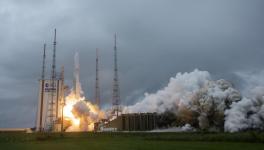NASA Spacecraft Touches Outer Atmosphere of Sun for First Time

Image source: Flickr.com. Image is for representative use only
The Sun’s outer atmosphere, the corona has been an untouched region until recently when a spacecraft projected by the NASA (National Aeronautics and Space Administration), United States, touched the area. The Sun’s corona has remained the most sought after destination by astronauts and space scientists. This ever-exciting region has got the foot mark of human endeavor in the form of the space craft Parker Solar Probe.
Expressing excitement, Nicola Fox, the director of NASA’s heliophysics division, commented saying,” We have finally arrived. Humanity has touched the Sun.” Fox and other team members declared the mission’s accomplishment at a press conference of American Geophysical Union this week. The findings of the team also appeared in a paper published in PRL (Physical Review Letters).
The Parker Solar Probe crossed Sun’s atmosphere on April 28, but scientists involved in the mission had to spend several months downloading and analysing the data collected by the spacecraft. The team had to carry out several calculations and analyses to make sure that the spacecraft indeed crossed the boundary known as Alfven surface. This surface indicates the interface of sun’s atmosphere and an outer space, where solar winds dominate. Solar wind is a stream of charged particles emanating from the upper atmosphere of the Sun.
The name Alfven Surface also has a history traceable to half a century back. In 1942, Swedish physicist Hannes Alfven proposed a theoretical marvel about the existence of the surface. Hannes Alfven’s paper was published in the Nature in 1942. Since then, scientists have been looking for it and Parker Solar Probe’s entry into it is surely a milestone in space science.
Parker was launched in 2018 and since then it has been orbiting the Sun. With each pass, the craft loops over closer to the surface of the Sun. The craft has a carbon composite shield which protects the instruments inside it from the scorching heat of around 1370 degree Celsius. The craft crossed the Alfven boundary when it was at a distance of about 14 million kilometres from the Sun’s surface. From theoretical predictions, this was the distance where scientists had expected to find the surface.
Earlier, some scientists thought that the boundary would be rather blurry, but in fact, it was sharp and wrinkly. The spacecraft’s trajectory as analysed by the team revealed that it was into the corona for nearly five hours and then got back out. It is also possible that the spacecraft have crossed the corona twice. Inside the corona the solar wind speed along with plasma (A collection of charged particles) densities dropped. This was suggestive that the spacecraft indeed crossed the boundary. Nour Raouafi, the mission’s project scientist was quoted to have said, “ We are learning new things that we did not have access to before.”
As the craft crossed the Alfven surface, it had to flow through a stream of electrically charged material. Inside it, the conditions are quieter than what is outside—quite a rough environment. Being inside the corona of the Sun, the spacecraft was able to study some of the unusual kinks present in the magnetic field of the solar wind. These are known as the ‘switchbacks’. Scientists were aware of the switchbacks, but the spacecraft’s data enabled them to get more information about these, especially about where the switchbacks come from.
The Parker probe finally aims to make 24 close passes around the Sun, with the mission’s closest approach scheduled for the year 2025. At that point the spacecraft is aimed to be only 6.2 million kilometres from the surface of the Sun, which will be another exciting moment to witness.
Get the latest reports & analysis with people's perspective on Protests, movements & deep analytical videos, discussions of the current affairs in your Telegram app. Subscribe to NewsClick's Telegram channel & get Real-Time updates on stories, as they get published on our website.















